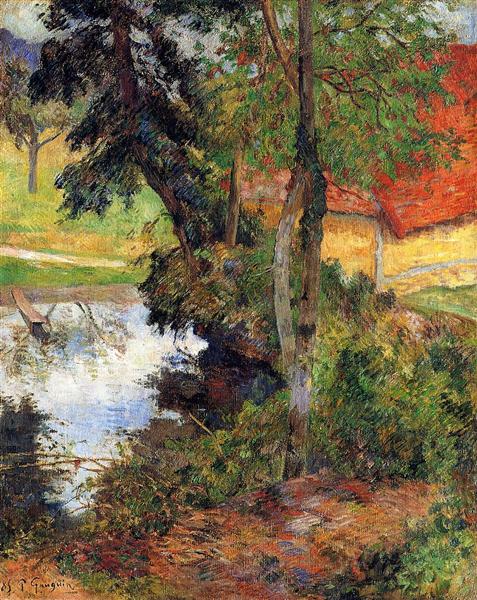विवरण
Paul Gauguin's "Red Roof by the Water" (1885) is part of a crucial moment in the history of art, where the transitions between Impressionism and Symbolism outline a new creative path. In this painting, Gauguin demonstrates his mastery in creating compositions that, although based on the representation of the outside world, invite the viewer to a more introspective and emotional experience.
The painting presents a simple but vibrant landscape. The tones of the sky and nature reverberate in the background, nuanced by the light that shines on the scene. The central element is a red tiled building, whose inclination and colour saturation attract the eye and establish a strong contrast with the natural environment that surrounds it. The choice of the vibrant red colour of the roof is a resource that Gauguin uses effectively to give personality to the work; it acts as a visual and emotional beacon that highlights life in the rural landscape.
In the foreground, a body of water can be seen that reflects the image of the building, creating a dialogue between nature and the built. This play of reflections becomes a key element that not only adds depth to the composition, but also suggests the duality between the real and the imagined, between the tangible and the ephemeral. The surface of the water emanates a calm that contrasts with the intensity of the red roof, perhaps symbolizing the tranquility of daily life, but also awakening a sense of longing and contemplation in the viewer.
The color palette in “Red Roof by the Water” is typically Gauguinesque; it relies on a bold use of saturations and hues that transcend mere naturalistic representation. The interplay between the greens, blues, and browns of the surroundings and the warm tones of the building, especially the warmth of red and orange, create a rich and immersive visual experience. Each color seems to select its own voice within the painting, contributing to a meditative visual symphony.
Although no human figures appear in the painting, the composition does not seem devoid of character or life. On the contrary, the subtle presence of architecture in the landscape suggests stories of past and present lives, suggesting a human interaction with the environment. This use of empty space in visual narrative is a prominent feature in Gauguin's later works, which combine the physical with the metaphysical, the known with the unknown.
“Red Roof by the Water” aligns with the aesthetic path that Gauguin would take in his later years, especially during his time in Polynesia. The way he suggests religion, symbolism, and emotions through color and composition are already glimpsed in this early work. Through this piece, one can discern the seeds of symbolism that Gauguin would cultivate more regularly later on, exploring the use of color not only as an aesthetic medium, but also as a vehicle for emotional and spiritual expression.
In short, “Red Roof by the Water” is more than just a landscape; it is a meditation on the essence of rural life, the resistance of color, and the search for meaning beyond the surface of reality. In this work, Gauguin not only captures a scene, but also provides an introspective perspective that invites the viewer to dive into deeper contemplation, displaying his unique ability to transform a simple slum into an emotional and symbolic reference point.
KUADROS ©, a famous painting on your wall.
Hand-made oil painting reproductions, with the quality of professional artists and the distinctive seal of KUADROS ©.
Painting reproduction service with satisfaction guarantee. If you are not completely satisfied with the replica of your painting, we will refund 100% of your money.

